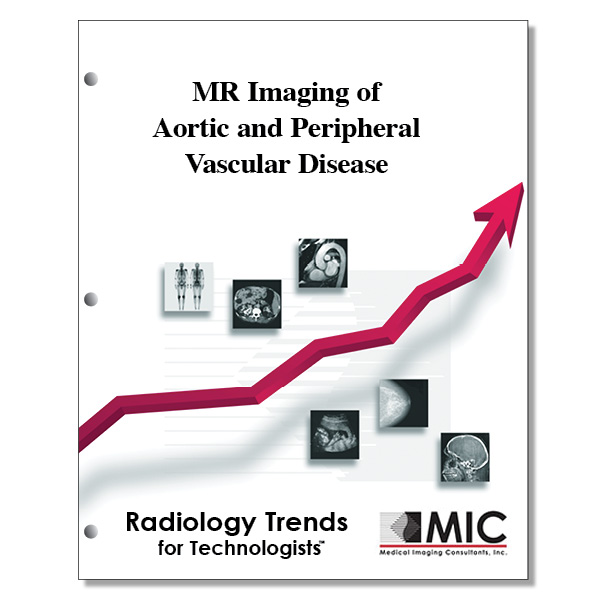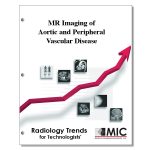

MR Imaging of Aortic and Peripheral Vascular Disease
An overview of the advances that have made MRI the primary modality for imaging the aorta and its branches.
Course ID: Q00080 Category: Radiology Trends for Technologists Modalities: MRI, Vascular Interventional2.75 |
Satisfaction Guarantee |
$29.00
- Targeted CE
- Outline & Objectives
- Objectives
Targeted CE per ARRT’s Discipline, Category, and Subcategory classification for enrollments starting after August 22, 2024:
[Note: Discipline-specific Targeted CE credits may be less than the total Category A credits approved for this course.]
Cardiac-Interventional Radiography: 0.50
Procedures: 0.50
Diagnostic and Electrophysiology Procedures: 0.50
Computed Tomography: 0.75
Procedures: 0.75
Head, Spine, and Musculoskeletal: 0.25
Neck and Chest: 0.25
Abdomen and Pelvis: 0.25
Magnetic Resonance Imaging: 2.75
Image Production: 0.75
Data Acquisition, Processing, and Storage: 0.75
Procedures: 2.00
Body: 1.00
Musculoskeletal: 1.00
Registered Radiologist Assistant: 2.00
Procedures: 2.00
Neurological, Vascular, and Lymphatic Sections: 2.00
Sonography: 0.50
Procedures: 0.50
Abdomen: 0.25
Superficial Structures and Other Sonographic Procedures: 0.25
Vascular-Interventional Radiography: 0.75
Procedures: 0.75
Vascular Diagnostic Procedures: 0.75
Vascular Sonography: 0.75
Procedures: 0.75
Abdominal/Pelvic Vasculature: 0.25
Arterial Peripheral Vasculature: 0.25
Venous Peripheral Vasculature: 0.25
Outline
- Introduction
- MR Angiography Tehniques
- Black-Blood Vascular Imaging
- Phase-Contrast Imaging
- TOF MR Angiography
- Dynamic Contrast-Enhanced MR Angiography
- MR Angiography of Peripheral Arteries
- Three-Station, Moving-Table Contrast-Enhanced MR Angiography
- Hybrid Methods
- Clinical Applications
- Aortic Disease
- Peripheral Artery Disease
- New Develpments
- Conclusion
Objectives
Upon completion of this course, students will:
- be familiar with the benefits of vascular imaging with MRI and CT
- know the MRI techniques commonly used to evaluate vessels
- know which MRA technique is used most commonly
- understand how intra-mural hematoma is best demonstrated
- know what type of vascular sequence is characterized by dual inversion pulses
- know which vascular sequence is commonly prescribed perpendicular to the vessel or interest
- be familiar with the type of sequence that flow quantification is done using
- be familiar with the characteristics of 2D-phase contrast imaging
- know which pulse sequence replaced time-of-flight for most applications
- understand the phenomena behind time-of-flight imaging
- know how many separate combined scans phase-contrast sequences consist of
- be familiar with the benefits of contrast-enhanced MRA
- know the results of incorrect timing for contrast-enhanced MRA
- know how to eliminate bright signal from fat in contrast-enhanced MRA
- understand which pulse sequence is used in contrast-enhanced MRA
- be familiar with what gradient spoiling is used for
- know how to improve a patients breath holding ability
- be familiar with the accuracy of the various methods for calculating delay timing
- understand why time-of-flight is often used in conjunction with contrast-enhanced MRA
- understand the characteristics of the hybrid contrast-enhanced MRA technique for runoff vessels
- know the common indications for aortic MRA
- be familair with what aortic aneurysms most commonly occur secondary to
- know where artherosclerotic aneurysms are most common
- know where mycotic aneurysms are most commonly found
- be familiar with the type of aneurysms Marfan syndrome typically causes
- be familiar with what mycotic aneurysms are typically secondary to
- be familair with what aortic dissections are commonly secondary to
- know when Dissection is most critical
- understand which artery of the leg is most susceptible to aneurysm
- know the clinical areas in which MRA is typically superior to conventional angiography
- understand what type of imaging is best at visualizing vessel walls
- know the type of flow phase-contrast images show as black pixels
- understand what ghosting of pulsatile vessels is characteristic of
- understand how pulsatile ghosting can be overcome
- know what type of MRA a tracking presaturation band is used for
- understand the causes of ringing artifacts on a contrast-enhanced MRA
- know the key factors for achieving T1-weighting in contrast-enhanced MRA
- know what tibial arterial disease is particularly common secondary to
- understand what structure is particularly important to demonstrate in patients requiring tibial bypass
- know the biggest pitfall in bypass graft evaluation
